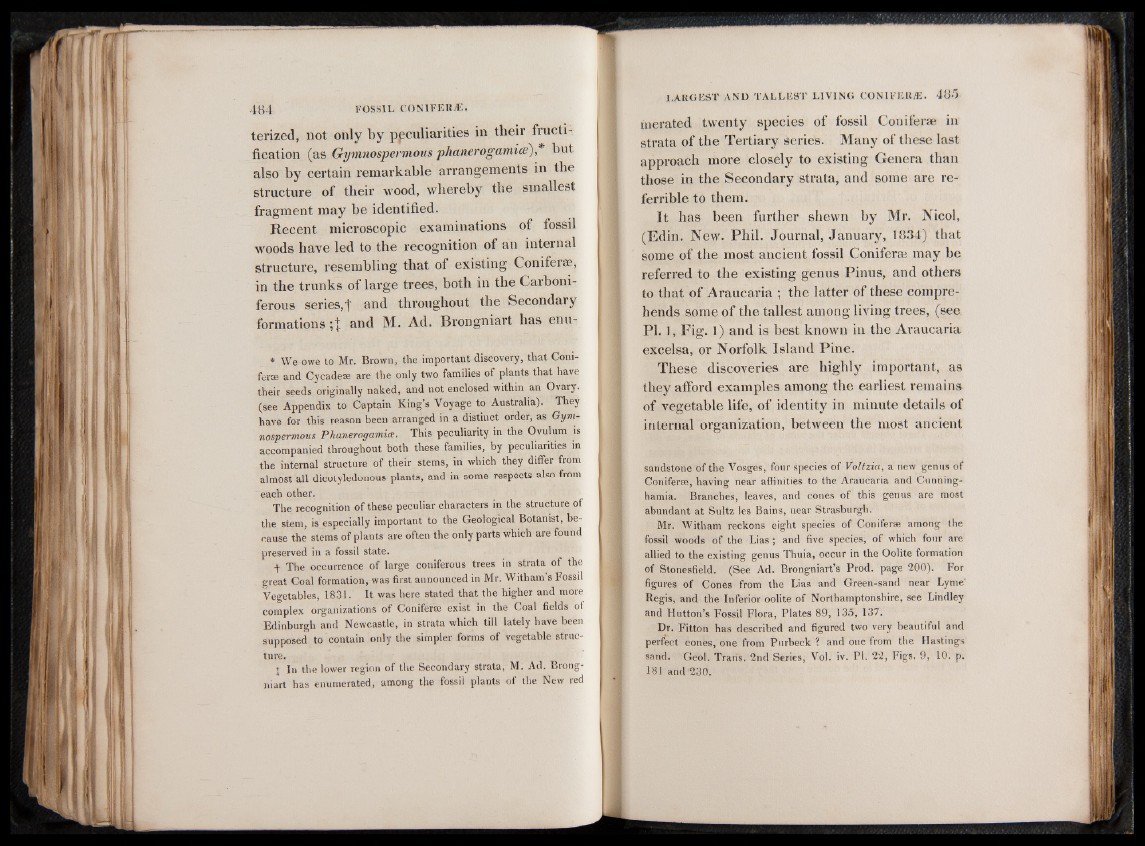
terized, not only by peculiarities in their fructification
(as Gymnospermous phanerogamioe),* but
also by certain remarkable arrangements in the
structure of their wood, whereby the smallest
fragment may be identified.
Recent microscopic examinations of fossil
woods have led to the recognition of an internal
structure, resembling that of existing Coniferae,
in the trunks of large trees, both in the Carboniferous
series,')' and throughout the Secondary
formations and M. Ad. Brongniart has enu-
* We owe to Mr. Brown, the important discovery, that Conifer
® and Cvcade® are the only two families of plants that have
their seeds originally naked, and not enclosed within an Ovary,
(see Appendix to Captain King’s Voyage to Australia). They
have for this reason been arranged in a distinct order, as Gym-
nospermous Phanerogamic*. This peculiarity in the Ovulum is
accompanied throughout both these families, by peculiarities in
the internal structure of their stems, in which they differ from
almost all dicotyledonous plants, and in some respects also from
each other.
The recognition of these peculiar characters in the structure of
the stem, is especially important to the Geological Botanist, because
the stems of plants are often the only parts which are found
preserved in a fossil state.
t The occurrence of large coniferous trees in strata of the
great Coal formation, was first announced in Mr. Witham s Fossil
Vegetables, 1831. It was here stated that the higher and more
complex organizations of Conifer® exist in the Coal fields of
Edinburgh and Newcastle, in strata which till lately have been
supposed to contain only the simpler forms of vegetable structure.
1 In the lower region of the Secondary strata, M. Ad. Brong-
niart has enumerated, among the fossil plants of the New red
LARGEST AND TALLEST LIVING CONIEEILE. 483
merated twenty species of fossil Coniferae in
strata of the Tertiary series. Many of these last
approach more closely to existing Genera than
those in the Secondary strata, and some are re-
ferrible to them.
It has been further shewn by Mr. Nicol,
(Edin. New. Phil. Journal, January, 1834) that
some of the most ancient fossil Coniferae may be
referred to the existing genus Pinus, and others
to that of Araucaria ; the latter of these comprehends
some of the tallest among living trees, (see
PI. 1, Fig. 1) and is best known in the Araucaria
excelsa, or Norfolk Island Pine.
These discoveries are highly important, as
they afford examples among the earliest remains
of vegetable life, of identity in minute details of
internal organization, between the most ancient
sandstone of the Vosges, four species of Voltzici, a new genus of
Conifer®, having near affinities to the Araucaria and Cunning-
hamia. Branches, leaves, and cones of this genus are most
abundant at Sultz les Bains, near Strasburgh.
Mr. Witham reckons eight species of Conifer® among the
fossil woods of the Lias ; and five species, of which four are
allied to the existing genus Thuia, occur in the Oolite formation
of Stonesfield. (See Ad. Brongniart’s Prod, page 200). For
figures of Cones from the Lias and Green-sand near Lyme'
Regis, and the Inferior oolite of Northamptonshire, see Lindley
and Hutton’s Fossil Flora, Plates 89, 135, 137.
Dr. Fitton has described and figured two very beautiful and
perfect cones, one from Purbeck ? and one from the Hastings
sand. Geol. Traris. 2nd Series, Vol. iv. PI. 22, Figs. 9, 10. p.
181 and 230.